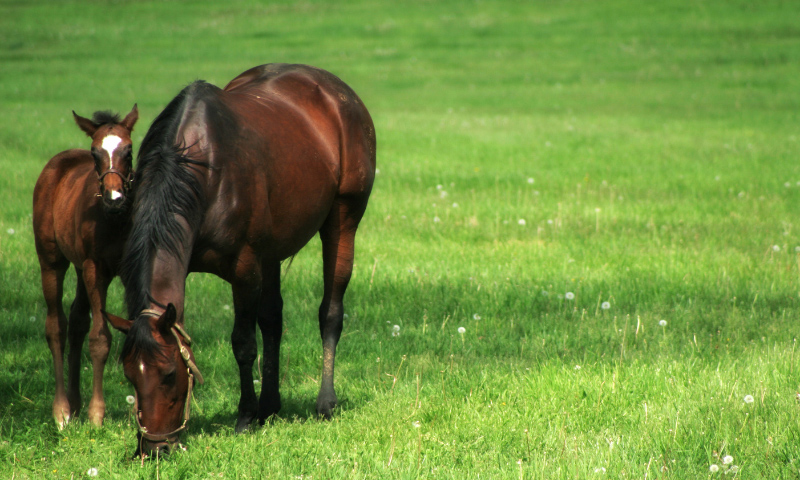Bighead or its correct name of Nutritional Secondary Hyperparathyroidism (NSH), is a condition that develops because of a calcium imbalance within the horse’s diet. When horses are deprived of calcium, they will take calcium and phosphorus from their bones to maintain blood calcium levels within a normal range. If horses are kept in this calcium deficient state for a sufficient period, there will have been so much calcium and phosphorus taken from the bones that they become fibrous, brittle, and weak. Bighead can have severe and debilitating effects on horses including difficulty breathing, painful movement, lameness, ill-thrift, bones that easily break, the characteristic enlarged facial bones, changes in behaviour and even death!
What symptoms can indicate that bighead is an issue?
Despite the name, ‘bighead’ facial swellings are not always a symptom, as this sign is more prevalent in young horses because their facial bones are not fully formed and hardened (although older horses may still experience swellings). As outlined by Richards (2017), Hungerford (1990) Kohnke (1999) and McKenzie et al (1981) signs can include, but are not limited to the following:
- Shifting lameness, sore bones and joints
- Ligament and tendon injuries
- Noisy breathing and nasal discharge
- Ill-thrift and harsh coat
- Enlarged/swollen facial bones (ridge over nasal bone)
- Early tiring and a low tolerance for work
- Loose and shifting teeth and difficulty chewing
How do horses get bighead?
Bighead in horses develops from two main situations.
- When a diet has incorrect calcium to phosphorus ratio, where phosphorus is more abundant than calcium. The higher levels of phosphorus can block the absorption of calcium and eventually lead to a severe calcium deficiency. The feeding of large amounts of ingredients such as wheat bran, pollard (also known as millrun, millmix and wheat middlings), copra, rice bran and cereal grains can disrupt this ratio as they contain high levels of phosphorus and very little calcium.
- Allowing horses to exclusively graze sub-tropical grasses like setaria, buffel, kikuyu, purple pigeon, green panic, pagnola, para, and signal grass that contain high levels of oxalate that binds to calcium making it unavailable for absorption by the horse. Calcium may be sufficiently present in these grasses, but horses cannot access it due to the high levels of oxalate, and long-term grazing can result in severe calcium deficiency. The greater the level of oxalate in the grass, the faster the horse may develop Bighead. According to Dr Nerida Richards (2012), “Setaria species contain the most dangerous levels of oxalate for horses, especially the Kazungula variety that contains a massive 70g/kg of oxalate, and this grass should really be considered toxic for horses”.
How to help horses avoid developing bighead
By providing horses with good nutrition in the form of a well-balanced diet, the development of Bighead can be avoided. To balance the diet of horses grazing high oxalate pasture, additional calcium needs to be provided by using calcium supplements or by increasing the intake of high calcium forages such as Lucerne Hay.
When supplementing horses that graze high oxalate pastures, it is important to supplement their diet with calcium and phosphorus while maintaining the correct calcium to phosphorus ratio. Enough calcium must be added to the diet to keep the calcium to oxalate ratio above 0.5 parts calcium to 1 part oxalate. For horses grazing setaria that contains massive levels of oxalates, it is recommended to supplement with both Lucerne Hay and a commercial supplement.
Balancing the calcium to phosphorus ratio will correct the issue if the condition is caused by excessive phosphorus levels. The ratio must be kept above one part calcium to one part phosphorus for all horses. For mature horses the ideal range is 1:1 to 6:1 and for young horses, this range will be 1:1 to 3:1 (Richards, 2017).
HOW CAN AGSOLUTIONS HELP HORSES GRAZING HIGH OXALATE PASTURES?
MegaMin Bone Defender has been formulated to provide enough high-quality and bioavailable calcium, magnesium (oxalates block magnesium absorption too) and phosphorus to assist in maintaining or balancing the calcium to oxalate ratio, allowing horses to maintain bone strength and to stay healthy and sound when grazing high oxalate subtropical pastures.
MegaMin Bone Defender has been specially formulated in conjunction with a leading Australian Equine Nutritionist to meet the calcium needs of horses with access to diets consisting largely of high oxalate pasture. The supplement has been scientifically balanced and has added vitamin D to help ensure optimum uptake from the digestive system. MegaMin Bone Defender is suitable for horses and ponies in all disciplines and is recommended to be fed in conjunction with MegaMin Equine Enhancer. The daily feeding rates are very detailed and based on the latest scientific research.

For further information please refer to the nutrition article Bighead In Horses or contact AgSolutions on 1800 81 57 57.
